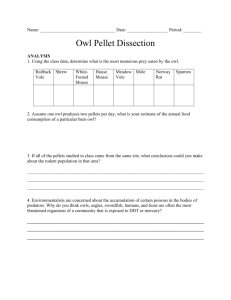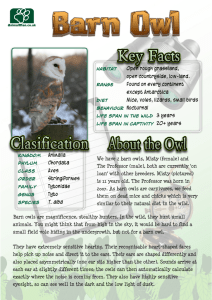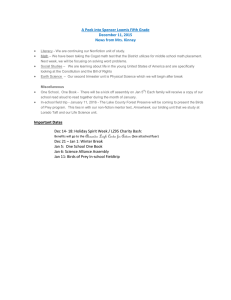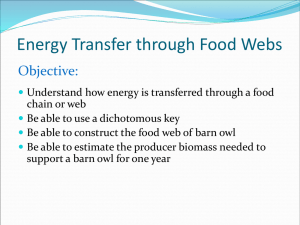Barn Owl - Biodiversity Centre for Wildlife Studies
advertisement
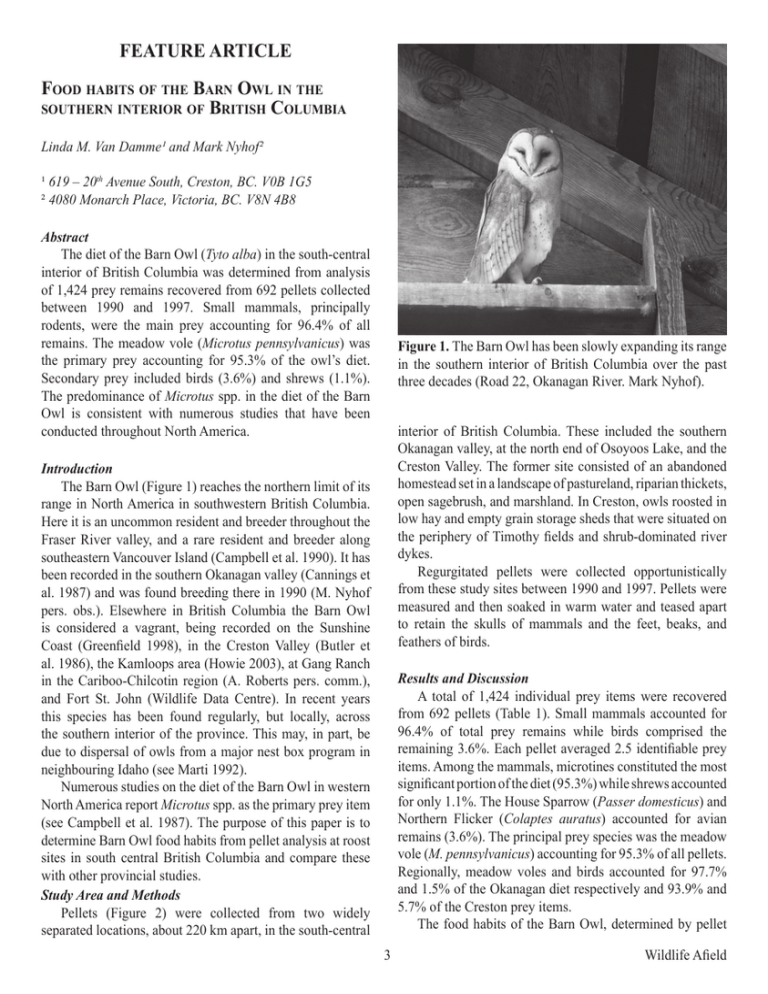
FEATURE ARTICLE FOOD HABITS OF THE BARN OWL IN THE SOUTHERN INTERIOR OF BRITISH COLUMBIA Linda M. Van Damme¹ and Mark Nyhof² ¹ 619 – 20th Avenue South, Creston, BC. V0B 1G5 ² 4080 Monarch Place, Victoria, BC. V8N 4B8 Abstract The diet of the Barn Owl (Tyto alba) in the south-central interior of British Columbia was determined from analysis of 1,424 prey remains recovered from 692 pellets collected between 1990 and 1997. Small mammals, principally rodents, were the main prey accounting for 96.4% of all remains. The meadow vole (Microtus pennsylvanicus) was the primary prey accounting for 95.3% of the owl’s diet. Secondary prey included birds (3.6%) and shrews (1.1%). The predominance of Microtus spp. in the diet of the Barn Owl is consistent with numerous studies that have been conducted throughout North America. Figure 1. The Barn Owl has been slowly expanding its range in the southern interior of British Columbia over the past three decades (Road 22, Okanagan River. Mark Nyhof). interior of British Columbia. These included the southern Okanagan valley, at the north end of Osoyoos Lake, and the Creston Valley. The former site consisted of an abandoned homestead set in a landscape of pastureland, riparian thickets, open sagebrush, and marshland. In Creston, owls roosted in low hay and empty grain storage sheds that were situated on the periphery of Timothy fields and shrub-dominated river dykes. Regurgitated pellets were collected opportunistically from these study sites between 1990 and 1997. Pellets were measured and then soaked in warm water and teased apart to retain the skulls of mammals and the feet, beaks, and feathers of birds. Introduction The Barn Owl (Figure 1) reaches the northern limit of its range in North America in southwestern British Columbia. Here it is an uncommon resident and breeder throughout the Fraser River valley, and a rare resident and breeder along southeastern Vancouver Island (Campbell et al. 1990). It has been recorded in the southern Okanagan valley (Cannings et al. 1987) and was found breeding there in 1990 (M. Nyhof pers. obs.). Elsewhere in British Columbia the Barn Owl is considered a vagrant, being recorded on the Sunshine Coast (Greenfield 1998), in the Creston Valley (Butler et al. 1986), the Kamloops area (Howie 2003), at Gang Ranch in the Cariboo-Chilcotin region (A. Roberts pers. comm.), and Fort St. John (Wildlife Data Centre). In recent years this species has been found regularly, but locally, across the southern interior of the province. This may, in part, be due to dispersal of owls from a major nest box program in neighbouring Idaho (see Marti 1992). Numerous studies on the diet of the Barn Owl in western North America report Microtus spp. as the primary prey item (see Campbell et al. 1987). The purpose of this paper is to determine Barn Owl food habits from pellet analysis at roost sites in south central British Columbia and compare these with other provincial studies. Study Area and Methods Pellets (Figure 2) were collected from two widely separated locations, about 220 km apart, in the south-central Results and Discussion A total of 1,424 individual prey items were recovered from 692 pellets (Table 1). Small mammals accounted for 96.4% of total prey remains while birds comprised the remaining 3.6%. Each pellet averaged 2.5 identifiable prey items. Among the mammals, microtines constituted the most significant portion of the diet (95.3%) while shrews accounted for only 1.1%. The House Sparrow (Passer domesticus) and Northern Flicker (Colaptes auratus) accounted for avian remains (3.6%). The principal prey species was the meadow vole (M. pennsylvanicus) accounting for 95.3% of all pellets. Regionally, meadow voles and birds accounted for 97.7% and 1.5% of the Okanagan diet respectively and 93.9% and 5.7% of the Creston prey items. The food habits of the Barn Owl, determined by pellet 3 Wildlife Afield 75% of the total diet (Campbell et al. 1987). In the Okanagan valley, at the study site listed in this paper, a sample of 100 pellets (211 prey remains – Table 1) collected in spring 1982 from a winter roost showed microtines predominated in the diet (87.6%) with the meadow vole (55.9%) and the montane vole (M. montanus - 19.9%) the most common species. Although the sample size is smaller for the Creston Valley, the preponderance of microtines (93.9%) is consistent with other British Columbia studies. It is known that Barn Owls can shift their diet seasonally to include more avian prey (Fritzell and Thorne 1984). On the south coast of British Columbia, birds representing 20 species contributed only 1.9% to the owl’s diet (Campbell et al. 1987) while there was only traces in the diet of interior Barn Owls (see Table 1). The dimensions of pellets collected from the interior study sites (n=150) ranged from 22 to 73 mm long and 13 to 44 mm wide. The mean pellet size was 47 by 29 mm. Figure 2. Barn Owl (Tyto Alba) pellets and decapitated meadow vole (Microtus pennsylvanicus) collected in the Creston Valley, BC. 7 September 1994 (Linda M. Van Damme). analysis, has been studied extensively on southeastern Vancouver Island and the lower Fraser River valley in extreme southwestern British Columbia. Here rodents and insectivores made up 98% of the Barn Owl’s diet with the Townsend’s vole (Microtus townsendi) constituting nearly Literature Cited Butler, R.W., B.G. Stushnoff, and E. McMackin. 1986. The birds of the Creston Valley and southeastern British Columbia. Canadian Wildlife Service Occasional Paper No. 58, Ottawa, ON. 37 pp. Table 1. Percent composition of major mammal and bird prey items in the diet of the Barn Owl (Tyto alba) in coastal and interior B.C. Vancouver Lower Fraser Okanagan Creston Prey Island¹ River Valley¹ Valley Valley³ MAMMALS Microtus longicaudus [7.1²] Microtus montanus [19.9²] Microtus pennsylvanicus [55.9²] 96.7³ 93.9 Microtus spp. [4.7²] Microtus townsendi 72.6 69.1 - 80 Mus musculus [9.5²] Peromyscus maniculatus 8.3 1.2 - 1.5 Sorex vagrans 0.6 - 7.2 [1.4²] Sorex spp. 12.0 3.2 - 15.9 [0.5²] 1.8³ 0.4 Thomomys talpoides [0.5²] BIRDS (TOTAL) - 1.9 Total Pellets 774 11,013 Total Prey Items 1,894 28,324 ¹ Campbell et al. (1987), ² Cannings et al. (1987), ³ This study. 1:1 July 2004 4 [0.5²] 1.5³ 5.7 [100²] 548³ [211²] 1,153³ 144 271 NOTES Campbell, R.W., D.A. Manuwal, and A.S. Harestad. 1987. Food habits of the Common Barn Owl in British Columbia. Canadian Journal of Zoology 65:578-586. Campbell, R.W., N.K. Dawe, I. McT.-Cowan, J.M. Cooper, G.W. Kaiser, and M.C.E. McNall. 1990. The birds of British Columbia: Volume 2 – Nonpasserines (Diurnal birds of prey through woodpeckers). Royal British Columbia Museum, Victoria, BC. 636 pp. Cannings, R.A., R.J. Cannings, and S.G. Cannings. 1987. Birds of the Okanagan Valley, British Columbia. Royal British Columbia Museum, Victoria, BC. 420 pp. Fritzell, E.K., and D.H. Thorne. 1984. Birds predominate in the winter diet of a Barn Owl. Wilson Bulletin 96:321. Greenfield, T. 1998. Birds of the Sunshine Coast – A Checklist. British Columbia Wildlife Watch Leaflet, Surrey, BC. Howie, R. 2003. Birds of Kamloops – Checklist and Status. Printed by the author. Kamloops, BC. Marti, C.D. 1992. Barn Owl (Tyto alba). In The Birds of North America, No. 1 (A. Poole, P. Stettenheim, and F. Gill, eds.). The Birds of North America, Inc., Philadelphia, PA. FIRST OCCURRENCE OF WANDERING SALAMANDER ON THE SUNSHINE COAST OF BRITISH COLUMBIA Glenn R. Ryder¹ and R. Wayne Campbell² ¹Lions Grove Estates, #302, 2888 – 273rd Street, Aldergrove, BC. V4W 3M6 ²2511 Kilgary Place, Victoria, BC. V8N 1J6 The wandering salamander (Aneides vagrans) (Figure 1), formerly known as the clouded salamander (A. ferreus), occurs at low elevations on Vancouver Island and some adjacent offshore islands. Although it occurs in Oregon, there are no records from mainland Washington and only a few scattered historical records for the extreme southwest mainland coast of British Columbia. (Green and Campbell 1984; Corkran and Thoms 1996). The status of this species outside Vancouver Island is not well known. It is likely that this fairly common species was trapped in two separate refuges during the past Ice Age. The purpose of this paper is to document the presence of the wandering salamander on the mainland coast outside the lower Fraser River valley. While conducting fieldwork in BC Hydro transmission corridors on the Sunshine Coast, 21 km north of Vancouver, British Columbia, in spring and summer 2001, we located single wandering salamanders on three occasions. All records were from within transmission corridors even though nearby mixed coniferous and deciduous forests were searched. About the Authors Linda is an experienced field naturalist with a commitment to conservation of wildlife and their habitats. She has published widely and is a co-author of the Sky Lark account in The Birds of North America series published by the American Ornithologists’ Union in 1997. Her present research is centered in the Creston Valley where she lives. Mark is a well-known wildlife artist with a passion for field research. Personal projects have included field studies of the Long-eared Owl, Western Screech-Owl, Cooper’s Hawk, and forest songbirds. “The question is not what you look at, but what you see” - Henry David Thoreau Figure 1. Wandering Salamander (Aneides vagrans), Cleland Island, BC. 16 May 1970 (R. Wayne Campbell). 5 Wildlife Afield
